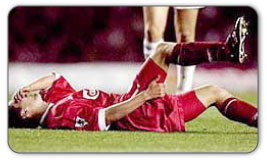Hamstring muscle strains can happen suddenly or over a period of time. Strains that happen suddenly are called acute hamstring strains or thigh pulls. Those that happen as a result of wear and tear over time are referred to as chronic hamstring strains.
Acute thigh pulls are caused by a direct hit, a fall or accident or overloading of the hamstring muscles or tendons. Overloading may occur during heavy lifting or with inactivity followed by an activity that uses the muscles as they are not normally used. (i.e. game of football on the weekend).

Chronic hamstring strains are generally caused by overuse or an old hamstring injury that did not heal properly. A chronic strain injury occurs most often as a result of not warming up before an activity or in the later stages of practices or games as a result of muscle fatigue. Activity during cold weather causes muscles to contract. A muscle in contraction is more likely to strain so warming them up gently when they are cold is important to prepare them for use and reduce the risk of a hamstring injury.
Young, active teens or adults between 25-44 years are most susceptible to thigh pulls, and men are twice as likely to be injured as women. The damage can range from overstretching to partial tearing to a complete hamstring rupture in the fibers.
Weak hamstring muscles also play a role in knee or low back injuries (cause your pelvis to tilt abnormally). If you allow hamstring injuries to persist they can lead to repeated injury, periostitis (inflammation of the periosteum), and prolonged disability.
Hamstring injuries are frustrating to live with and healing can take a long time because it's difficult to give your leg the rest it needs. This is especially true for runners and other athletes that return to their sport too early. Re-injury is common but it prolongs recovery and may also lead to permanent damage and other conditions.
Treating your hamstring strain correctly is essential to getting rid of your pain and restoring function to your upper thigh. Proper treatment will get you back to regular activities sooner, stop your pain, and reduce the risk of future re-injury.
To restore strength and range of motion in your hamstrings, treatment should focus on preventing scar tissue formation and muscle atrophy (shrinkage and weakening of the muscle). This requires rest and the appropriate therapies at the right time. Almost all types of hamstring pulls and tears (except a complete hamstring rupture) can be properly treated with trusted therapies that are available for use at home. Complete ruptures usually require surgery. However, using these home therapies after surgery can help speed recovery, improve function, and increase range of motion in your hamstrings.
Learn more about Hamstring Muscle Strain Treatments by clicking here
AidYourHamstring advisors do not work on commission, so be assured you will only receive fair and objective information.
Product Advisors are available 9:00 am to 5:00 pm Eastern Standard Time Monday to Friday.
I want to learn more about Surgery & Post-Surgery Recovery
I want to learn more about Circulation Boost
I want to learn more about Ice & Heat: Which Is Better For Treatment?
I want to learn more about Stretching for the Hamstring
I want to learn more about Soft Tissue Injury Treatments
During your recovery, you will probably have to modify and/or eliminate any activities that cause pain or discomfort at the location of your soft tissue injury until the pain and inflammation settle. The more diligent you are with your treatment and rehabilitation, the faster you will see successful results!
Please be aware that this information is neither intended nor implied to be a substitute for professional medical advice. CALL YOUR HEALTHCARE PROVIDER IMMEDIATELY IF YOU THINK YOU MAY HAVE A MEDICAL EMERGENCY. Always seek the advice of your physician or other qualified health provider before using any of our outstanding products to make sure they are right for you and your condition or if you have any questions regarding a medical condition. Always see your doctor for a proper diagnosis as there are often many injuries and conditions (some very serious) that could be the cause of your pain.
© 2025 In.Genu Design Group, Inc. Contact Us